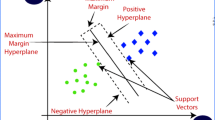Abstract
For the traditional steganographic method of Jsteg, the emmbedment of secret message is completed by dividing cover-image into nonoverlapping blocks of 8×8 pixels, discrete cosine transform (DCT) transforming, and using the standard 8×8 quantization table to quantize. In this paper, a novel steganographic method based on the JPEG quantization table modification is presented. Instead of dividing cover-image into 8×8 blocks, nonoverlapping blocks of 16×16 pixels is used. Both theoretical anlysis and experiment results show that the new methods has larger steganography capacity and better stego-image quality, compared with the method of Jsteg and Chang’s.
Similar content being viewed by others
References
Fridrich J, Goljan M, Hogea D, et al. Quantitative steganalysis: Estimating secret message length[J]. ACM Multimedia Systems Journal, 2003, 9(3): 288–302.
Hu Yun, Niu Xinxin, Yang Yixian. The study on the capacity of information hiding system on still images [J]. Journal of Electronics, 2004, 26(11): 1681–1685.
Fridrich J, Goljan M, Hogea D. Steganalysis of JPEG image: breaking the F5 algorithm[C]// The 5th International Workshop on Information Hiding. Berlin: Springer-Verlag, 2002: 310–323.
Li Xiaoxia, Wang Jianjun. A steganographic method based upon JPEG and particle swarm optimaziton algorithm[J]. Information Sciences, 2007, 177: 3099–3109.
Fridrich J. Feature-based steganalysis for JPEG images and its implications for future design of steganographic schemes [C] //Proceeding 6th Information Hiding Workshop. Berlin: Springer-Verlag, 2004: 67–81.
Westfeld A. F5-a steganographic algorithm: high capacity despite better steganalysis[C]//Proceeding of 4th International Workshop on Information Hiding. New York: Springer-Verlag, 2001: 289–302.
Lee Y K, Chen L H. High capacity image steganograhic model[J]. IEE Proceedings on Vision, Image and Signal Processing, 2000, 147(3): 288–294.
Lee Y K, Chen L H. Secure errror-free steganography for JPEG images[J].Jounal of Pattern Recognition and Artifical Intelligence, 2003, 17: 967–981.
Monro D M, Sherlock B G. Optimal quantisation strategy for DCT image signal processing[J]. IEE Proceeding on Vision, Image and Signal Processing, 1996, 143(1): 10–14.
Yu Y H, Chang C C, Hu Y C. Hiding secret data in images via predictive coding [J]. Pattern Recognition, 2005, 38: 691–705.
Chang C C, Chen T S, Chung L Z. A steganographic method based upon JPEG and quantization table modification[J]. Information Sciences, 2002, 141: 123–138.
Tseng H W, Chang C C. Steganography using JPEG-compressed images [C]//The Fourth International Conference on Computer and Information Technology. Wuhan: IEEE Computer Society Press, 2004: 12–17.
Almohammad A. High capacity steganographic method based upon JPEG[C]//Third International Conference on Availability, Reliability and Security. Washington: IEEE Computer Society Press, 2008: 544–549.
Huang J, Shi Y Q, Shi Y. Embedding image watermarks in DC components [J]. IEEE Transactions on Circuits and Systems for Video Technology, 2000, 10(6): 974–979.
Almohammad A, Ghinea G, Hierons R M. JPEG steganography: A performance evaluation of quantization tables [C]//The IEEE 23rd International Conference on Advanced Information Networking and Applications. Washington: IEEE Computer Society Press, 2009: 471–478.
Author information
Authors and Affiliations
Corresponding author
Additional information
Foundation item: Supported by the National Natural Science Foundation of China(50803016), the Fundamental Research Funds for the Central Universities
Biography: JIANG Cuiling, female, Lecturer, Ph. D., research direction: data hiding, image process.
Rights and permissions
About this article
Cite this article
Jiang, C., Pang, Y., Guo, L. et al. A high capacity steganographic method based on quantization table modification. Wuhan Univ. J. Nat. Sci. 16, 223–227 (2011). https://doi.org/10.1007/s11859-011-0740-0
Received:
Published:
Issue Date:
DOI: https://doi.org/10.1007/s11859-011-0740-0




